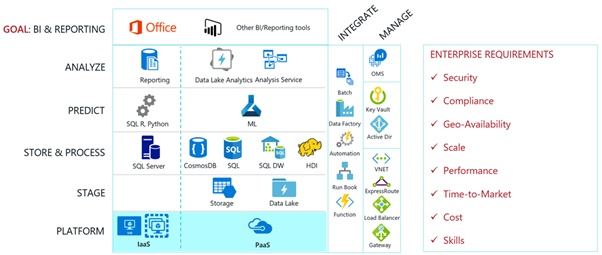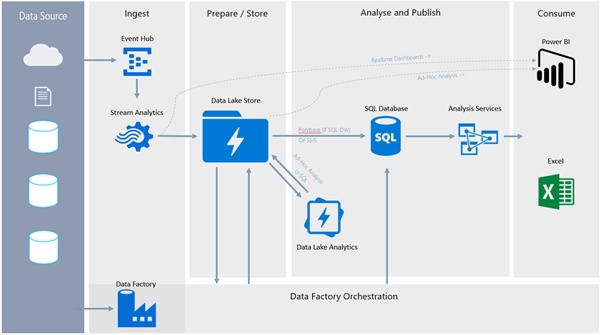PaaS (Platform as a Service) in Azure
You are here: >PaaS (Platform as a Service) in Azure
I love the cloud and PaaS in Azure! I think the first time I heard of it was way back when Google was launching its Google docs style apps and to me, it just made so much sense. No expensive upfront payments, your documents and work items available across all your devices if you could connect to the internet, and the apps would be updated for you as and when the developer pushed updates. Awesome!
Then the likes of Azure and AWS came on the scene (they did in my eyes anyway, I can’t remember what order everything was released or became most popular first), the idea of renting someone else’s hardware as and when you needed it, now more commonly known as IaaS (Infrastructure as a Service) was a great idea. Of course, early on you are always going to be weary around security and things like that, but the concept seemed so simple yet so useful. For me, though at the time I didn’t have the need, the business I was working for had plenty in terms of infrastructure and storage but was always cool to spin stuff up on in labs on any training courses I attended.
From a data and analytics point of view the offerings that have become available and gained traction over the last couple of years are where, in my eyes, things become really cool (nerd alert!). The PaaS offerings in Azure from a data platform are, from my point of view, very useful. Microsoft describes PaaS as:
Platform as a service (PaaS) is a complete development and deployment environment in the cloud, with resources that enable you to deliver everything from simple cloud-based apps to sophisticated, cloud-enabled enterprise applications. You purchase the resources you need from a cloud service provider on a pay-as-you-go basis and access them over a secure Internet connection.
Like IaaS, PaaS includes infrastructure – servers, storage and networking – but also middleware, development tools, business intelligence (BI) services, database management systems and more. PaaS is designed to support the complete web application life cycle: building, testing, deploying, managing, and updating.
PaaS allows you to avoid the expense and complexity of buying and managing software licences, the underlying application infrastructure and middleware or the development tools and other resources. You manage the applications and services that you develop, and the cloud service provider typically manages everything else.
And it’s that last paragraph where I think PaaS really comes into its own in the data and analytics space, you don’t have to worry about expensive upfront costs, you don’t need to spec an environment for its theoretical largest, it allows some of the less “tech savvy” amongst us to get started on a project without worrying about complicated Infrastructure.
Some organisations still like to have full control of their systems though and might opt for your more traditional cloud computing with a bunch of VMs, which is also fine but here are some of my thoughts when comparing IaaS to PaaS:
Advantages
| IaaS | PaaS |
| Business: Quick transition to Cloud | Business: Low Total Cost of Ownership |
| Technology: Mature ISV Ecosystem | Business: Accelerates Innovation |
| Technology: Complete Control | Technology: Better Development Operations |
| Technology: Solution Portability | Technology: Mitigates Vulnerability Risks |
Disadvantages
| IaaS | PaaS |
| Business: Expensive to Operate | Harder Cloud Transition |
| Business: Slows Down Innovation | Technology: Application Portability Issues |
| Business: Security Risks from Unpatched Servers | Technology: PaaS ISV Ecosystem is not as mature as IaaS |
| Technology: Difficult to Maintain Legacy Apps | Technology: Different Codebases for Cloud and Premise |
| Technology: Requires Rigorous Processes for Enabling DevOps | |
| Technology: Requires Rigorous Server Maintenance Processes |
Getting back to the data and analytics space, Microsoft Azure now has a full arrange of PaaS services to suit your needs. I will cover some of these services in more detail in a separate post but some of these include:
Azure Data Lake Store
https://azure.microsoft.com/en-gb/services/data-lake-store/
Azure Blob Storage
https://azure.microsoft.com/en-gb/services/storage/blobs/
SQL Database
https://azure.microsoft.com/en-gb/services/sql-database/
SQL Data Warehouse
https://azure.microsoft.com/en-gb/services/sql-data-warehouse/
Azure Cosmos Db
https://azure.microsoft.com/en-gb/services/cosmos-db/
Azure Data Lake Analytics
https://azure.microsoft.com/en-gb/services/data-lake-analytics/
HDInsight
https://azure.microsoft.com/en-gb/services/hdinsight/
Databricks
https://azure.microsoft.com/en-gb/services/databricks/
Data Factory V2
https://azure.microsoft.com/en-gb/services/data-factory/
Azure Stream Analytics
https://azure.microsoft.com/en-gb/services/stream-analytics/
Azure Analysis Services
https://azure.microsoft.com/en-gb/services/analysis-services/
Power BI (slightly different but to complete the platform)
https://powerbi.microsoft.com/en-us/features/
Together these services offer a full end to end data and analytics offering. Not only that but you have flexibility and choice to suit your project.

People far more suited than me explain this architecture better than I do and their blog posts can be found here –
http://www.jamesserra.com/archive/2018/01/reference-architecture-for-enterprise-reporting/
http://www.jamesserra.com/archive/2018/02/azure-data-architecture-guide-adag/
https://sqlofthenorth.blog/
Now I’m in a position where I am living and breathing these services every day and I try my absolute best to keep up with the frequent updates that keep coming. After carrying out several strategic reviews for customers now, I have started to build and refer to our own reference architecture, from a high level this is pretty much what it looks like:

To quickly sum up my thoughts… these services are definitely becoming more and more popular. Time and money is being spent on improving them, offering more features, making them easier to use, more supporting information so becoming more and more attractive propositions all the time! You might have been able to tell that I am a massive fan already and cannot wait to see what the future holds, not just for Azure’s data platform but for cloud computing as a whole (but mainly for Azure’s data platform ??).
- About Us
- Partners
- Careers
- Contact us
- eBECS and the Microsoft Core Data Platform
- Microsoft Dynamics NAV in Property Management
- Microsoft Dynamics Nav Manufacturing Solutions
- Microsoft Dynamics NAV Cloud pricing
- Drive your Azure Momentum with SQL Managed Instance
- Compare Microsoft Dynamics AX VS NAV
- Microsoft Azure Data Centre Migration Guide
- Microsoft Dynamics 365 Business Central or 365 for Finance & Operations?
- Introduction to Microsoft Dynamics 365 for Finance and Operations
- Microsoft Dynamics 365 Business Central or 365 for Finance & Operations? Thank You
- Microsoft Dynamics 365 Business Central or Dynamics 365 Finance
- Compare Microsoft ERP Solutions
- Compare Microsoft ERP Solutions, Dynamics NAV vs Dynamics 365 Business Central
- Microsoft Dynamics 365 Business Central Price
- Compare Microsoft ERP
Categories
- AI (3)
- Azure (2)
- Business Insights (1)
- Canvas Apps (1)
- Common Data Service (2)
- Crisis Communication (1)
- CRM (3)
- Customer Data Platform (1)
- Customer Insights (1)
- Data Analytics/BI (29)
- Data Management (1)
- Data Warehouse (1)
- Dynamics 365 (33)
- Dynamics 365 Finance (1)
- Dynamics 365 Sales Insights (1)
- Dynamics 365 Supply Chain Management (1)
- Dynamics AX (50)
- Dynamics CRM (22)
- Dynamics Field Service (10)
- Dynamics NAV (10)
- Dynamics Project Service Automation (PSA) (15)
- eBECS (4)
- eBECS Marketing (1)
- eBECS Policies (1)
- ERP (2)
- Internet of Things (IoT) (15)
- Master Planning AX (4)
- Microsoft 365 (1)
- Microsoft Lifecycle Services (4)
- Power Apps (4)
- Power Automate (3)
- Power BI (1)
- Power Platform (6)
- Power VIrtual Agent (1)
- PowerApps (2)
- Project Service Automation (2)
- Quality Management (1)
- Sales (1)
- Surface Hub (3)
- Top Tips (1)
News
Upcoming Events - Register Now
Join our list
eBECS will invite you to webinars, events and keep you up to date with relevant news. You can unsubscribe at any time.









